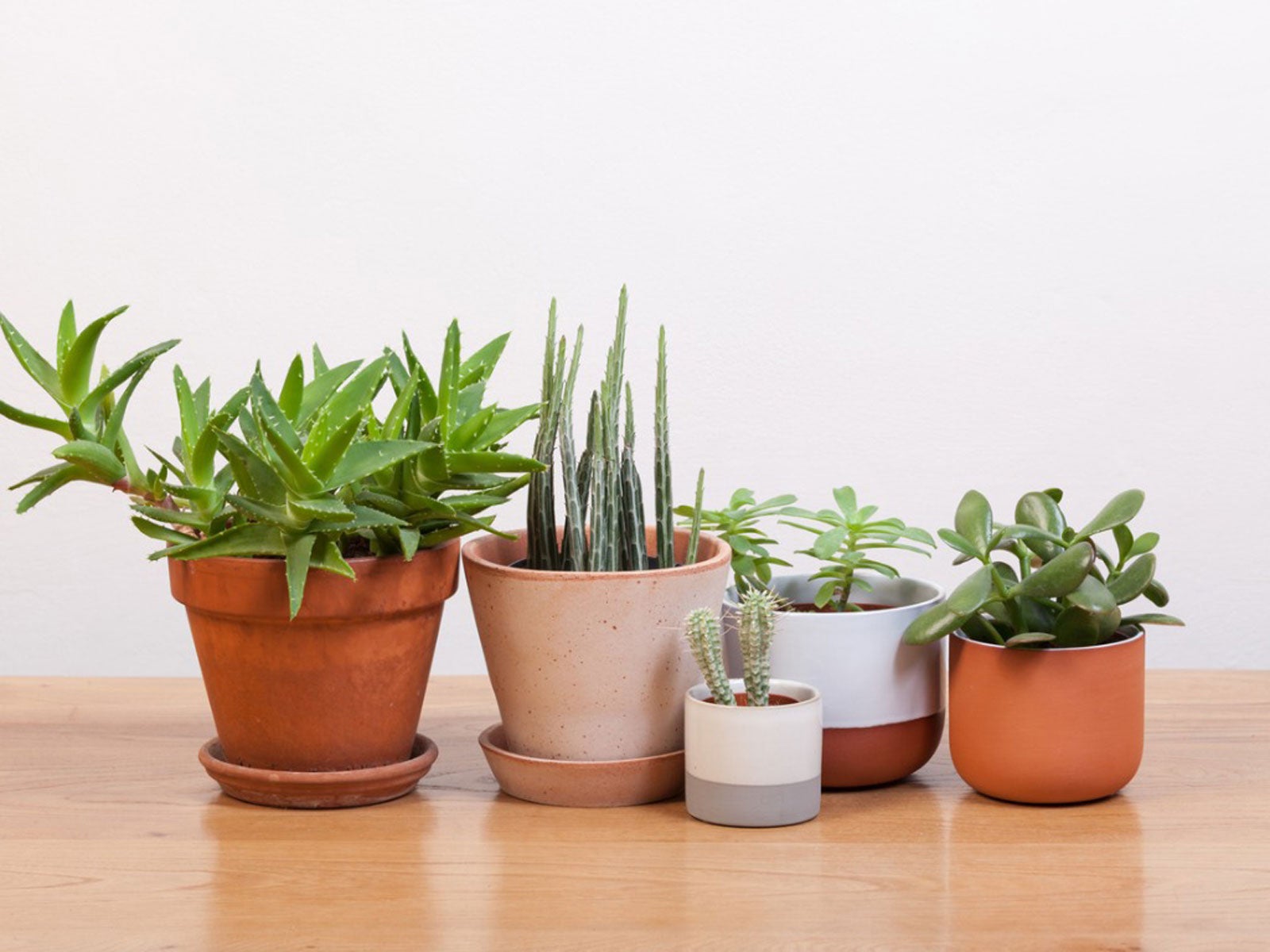Cacti And Succulents Inside Your Home


Growing cacti and other succulent plants can be an addictive pastime! Cacti are collectible and are ideal for nice, sunny windowsills as are many of their succulent counterparts. Read on to learn more about growing cactus and succulent plants indoors.
Cacti and Succulent Info
Cacti are associated with the desert, and many thrive in regions of Central and South America. Other cacti, though, come from as far north as Canada, and many are even native to the rainforests. Like bromeliads, a lot of cacti are epiphytes, and the cacti that are forest-dwelling species grow over forest trees. The desert-dwelling variety of cacti can survive for really long periods of time without rainfall. They get their moisture from dew or mist and store nutrients and moisture in their tissues. The word "succulent" means "juicy." Succulent plants have leaves or stems that are filled with juices, the stored water, and nutrients that allow the plant to grow. These leaves allow the plant to withstand harsh conditions all over the world. Normally, these leaves have a glossy or leathery appearance, and the texture actually helps protect them from excessive moisture loss. Storing moisture the way they do is what defines cacti as succulents. What makes a cactus a cactus is that they grow growths, known as areoles. These are cushioned growing points that are technically compressed branches. Spines, "wool" flowers, and offsets all grow from the areoles. A lot of succulents resemble cacti in every way except they don't grow spines. This is what makes a succulent a succulent and not a cactus. In all but one genus of cactus, the Pereskia, the plants do not have leaves. The bodies of cacti are usually globular or cylindrical in shape. Opuntias have round, segmented stems. Epiphyllums have stems that look more like strap-shaped leaves. A lot of cacti have prominent spines, barbs, or bristles and some have woolly hair. In fact, all cacti have spines even though they might be so small they're insignificant. It's not always appreciated that all cacti flower, and flower regularly if they are well-looked after.
Cacti and Succulents in the Home
There are a lot of succulent plants that can be grown in your home, and some of them are among the easiest plants to care for. They are actually great plants for beginners, but as with any gardening and houseplant growing, you have to know what you're doing and dealing with in order to do well at growing them. Cacti and succulents make a great display, from the beautiful Nopalxochia ackermanii and the large flowers of the Epiphyllums (orchid cactus) to the weird and wonderful Astrophytum asterias (sea urchin cactus) or the hairy Cephalocereus senilis (old man cactus). It's a shame that these plants are not cultivated more often! They are undemanding and will withstand most maltreatment except for overindulgence. Overindulgence accounts for those that are sitting around all dusty on people's windowsills or those that are mushy and rotting from overwatering. They need bright light and fresh air, and they need a cool, dry, winter rest as well. Forest cacti tend to trail and have large flowers. This makes them perfect for individual displays in hanging baskets. The desert types have interesting shapes and textures and can be highlighted in a grouped display. Planting a group of succulents or cacti in one larger bowl is very effective. Larger plants like aloes and agaves look best in a pot of their own. Any large shallow pot can be used as an excellent pot for a cacti or succulent garden. You want to select plants all about the same size with similar care requirements. These plants all require a lot of light, so make sure the container you select fits near a window. A layer of fine grit over the compost gives an attractive, yet, dry surface for the cacti in the pot. You can place clean pebbles between the plants to increase the desert effect. Some cacti look attractive in little pots all in a row. The mutant cultivars of Gymnocalycium mihanovichii are great in this way because they have different colored heads.
Caring for Succulents and Cacti Plants
Most succulents and cacti require a lot of light. They are suitable for the sunniest of spots in your home. If you build some shelves across a sunny window you will be providing them with what they love. You want to be sure to turn the plants regularly to make sure all sides of the plant get equal sunny exposure. Every garden center has a great collection of cacti and succulents you can grow in your home. Some cacti, like the forest-growing Schlumbergera x buckleyi (Christmas cactus), are sold as seasonal plants or gift plants in department stores. It's best to buy cacti that are already in flower because it takes years for this to happen. You should check them over and make sure they are sound with no trace of rot or areas that are shriveled or dry. They should be just the right size for their pot and you should make sure that they are not exposed to drafts when you get them home. If you purchase desert cacti, make sure they are planted in well-drained compost. They should be well watered with tepid water in spring and summer. However, the compost should be allowed to almost completely dry in the winter months, especially if they are in cool conditions. This allows the cacti to go dormant. During periods of active growth, cacti should be fed about once every three weeks. You can use well-diluted tomato fertilizer for this purpose. Also, desert cacti like temperatures of 50-55 F. (10-13 C.). in the winter. You only need to repot desert cacti when the roots completely fill the pot. Forest cacti are very different. They usually have beautiful, hanging flowers that grow from the tips of segmented stems. These stems look like chains of fleshy leaves. They grow this way because they've been trained to grow over trees. They are used to shade, but they do need some bright light. They need lime-free, light compost that is well-drained and should be misted with tepid, soft water. They can be rested in 50-55 F. (10-13 C.). Water them moderately and feed them weekly with a weak fertilizer after winter and place them in a room with higher temperatures. There are 50 or more families of plants that can be considered succulents. They should be watered freely in the summer but only when their compost becomes dry. In the winter, they tolerate temperatures around 50 F. (10 C.). In the summer you should fertilize with well-diluted fertilizer every few weeks and they prefer fresh air instead of humidity. Desert cacti, forest cacti, and succulents can all be grown together. They make stunning displays for your houseplant collection. They don't take a lot of care, but you still need to know what they like and need.
Sign up for the Gardening Know How newsletter today and receive a free copy of our e-book "How to Grow Delicious Tomatoes".

Heather Rhoades founded Gardening Know How in 2007. She holds degrees from Cleveland State University and Northern Kentucky University. She is an avid gardener with a passion for community, and is a recipient of the Master Gardeners of Ohio Lifetime Achievement Award.